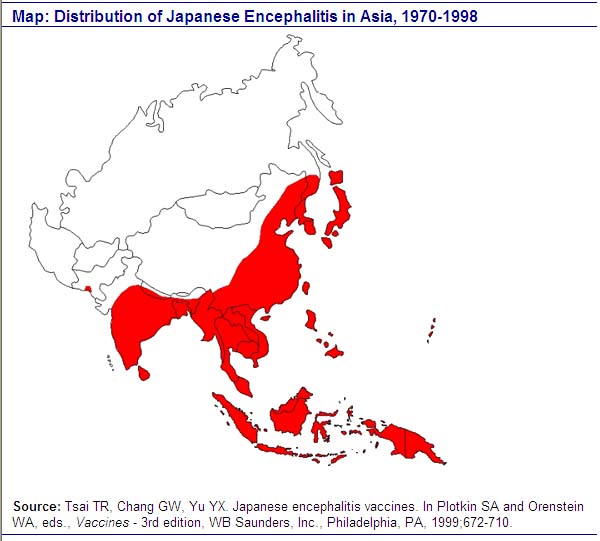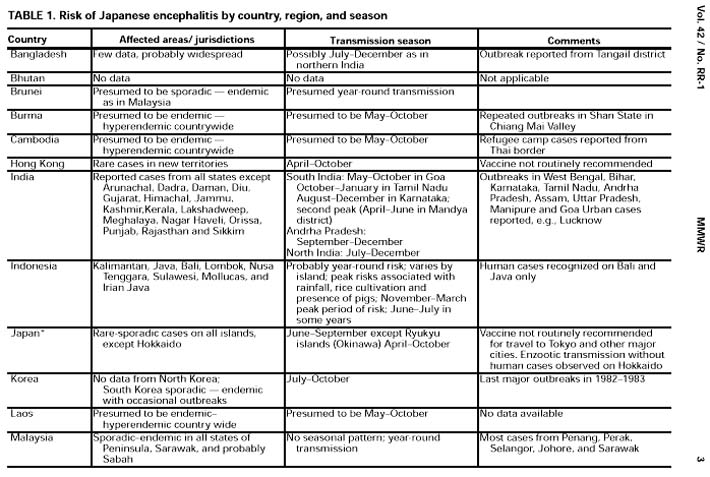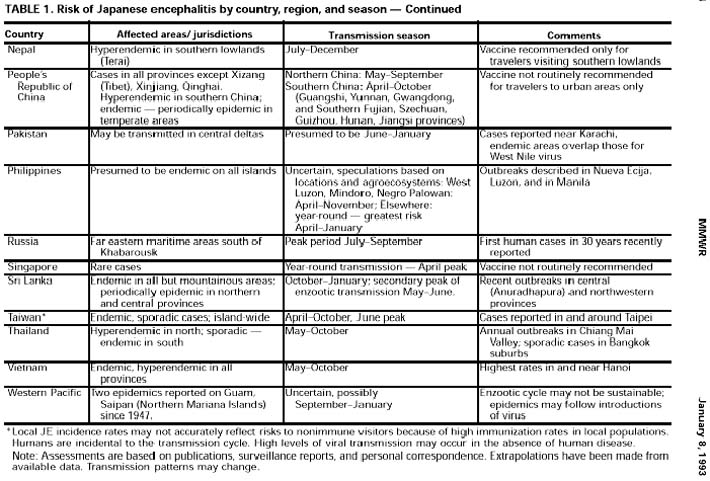Japanese encephalitis epidemiology and demographics: Difference between revisions
No edit summary |
No edit summary |
||
| Line 10: | Line 10: | ||
*Rare outbreaks in U.S. territories in Western Pacific | *Rare outbreaks in U.S. territories in Western Pacific | ||
*[[Case fatality rate]]s range from 0.3% to 60%. | *[[Case fatality rate]]s range from 0.3% to 60%. | ||
*Case-fatality ratio: 30% | |||
*Serious neurologic sequela: 30% | |||
Japanese encephalitis outbreaks are usually circumscribed and do not cover large areas. They usually do not last more than a couple of months, dying out after the majority of the pig amplifying hosts have become infected. Birds are the [[natural host]]s for Japanese encephalitis. Epidemics occur when the virus is brought into the peridomestic environment by mosquito bridge vectors where there are pigs, which serve as [[amplification host]]s, infecting more mosquitoes which then may infect humans. Countries which have had major [[epidemic]]s in the past, but which have controlled the disease primarily by [[vaccination]], include China, Korea, Japan, Taiwan and Thailand. Other countries that still have periodic epidemics include Viet Nam, Cambodia, Myanmar, India, Nepal, and Malaysia. | Japanese encephalitis outbreaks are usually circumscribed and do not cover large areas. They usually do not last more than a couple of months, dying out after the majority of the pig amplifying hosts have become infected. Birds are the [[natural host]]s for Japanese encephalitis. Epidemics occur when the virus is brought into the peridomestic environment by mosquito bridge vectors where there are pigs, which serve as [[amplification host]]s, infecting more mosquitoes which then may infect humans. Countries which have had major [[epidemic]]s in the past, but which have controlled the disease primarily by [[vaccination]], include China, Korea, Japan, Taiwan and Thailand. Other countries that still have periodic epidemics include Viet Nam, Cambodia, Myanmar, India, Nepal, and Malaysia. | ||
Revision as of 18:48, 29 November 2012
|
Japanese encephalitis Microchapters |
|
Diagnosis |
|---|
|
Treatment |
|
Case Studies |
|
Japanese encephalitis epidemiology and demographics On the Web |
|
American Roentgen Ray Society Images of Japanese encephalitis epidemiology and demographics |
|
Japanese encephalitis epidemiology and demographics in the news |
|
Blogs on Japanese encephalitis epidemiology and demographics |
|
Risk calculators and risk factors for Japanese encephalitis epidemiology and demographics |
Editor-In-Chief: C. Michael Gibson, M.S., M.D. [1]
Overview
Epidemiology and Demographics

- Leading cause of viral encephalitis in Asia with 30-50,000 cases reported annually
- Fewer than 1 case/year in U.S. civilians and military personnel traveling to and living in Asia
- Rare outbreaks in U.S. territories in Western Pacific
- Case fatality rates range from 0.3% to 60%.
- Case-fatality ratio: 30%
- Serious neurologic sequela: 30%
Japanese encephalitis outbreaks are usually circumscribed and do not cover large areas. They usually do not last more than a couple of months, dying out after the majority of the pig amplifying hosts have become infected. Birds are the natural hosts for Japanese encephalitis. Epidemics occur when the virus is brought into the peridomestic environment by mosquito bridge vectors where there are pigs, which serve as amplification hosts, infecting more mosquitoes which then may infect humans. Countries which have had major epidemics in the past, but which have controlled the disease primarily by vaccination, include China, Korea, Japan, Taiwan and Thailand. Other countries that still have periodic epidemics include Viet Nam, Cambodia, Myanmar, India, Nepal, and Malaysia.

